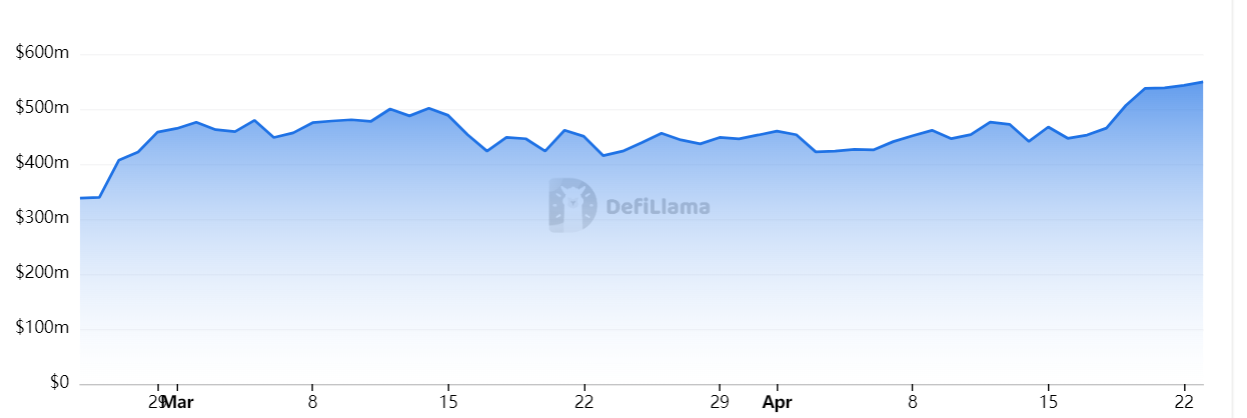After the bankruptcy of Genesis Trading, Babel Finance, and Celsius, the Bitcoin ecosystem was left with a significant void in financial service provision. This caused underutilization of BTC assets and missed opportunities for profit, especially in sectors like DeFi and NFTs
The inherent conservatism of Bitcoin holders is not the only thing that prevents them from missing out on lucrative yield opportunities. On the inside, the absence of a robust smart contract platform within the Bitcoin ecosystem also limits the development of complex decentralized applications (dApps).
This is where BounceBit steps in to fill the gap. BounceBit is building a BTC restaking infrastructure that provides a foundational layer for different restaking products, secured by the regulated custody of Mainnet Digital (a premier asset management and fintech platform) and Ceffu ( a secure environment for storing digital currencies for institutional entities).
BounceBit’s TVL soared to over $600 million within a month after Early Access Launch ($550 million as of April 23), complemented by securing $6 million in seed funding from leading investors Blockchain Capital and Breyer Capital.

How does BounceBit work?
BounceBit supports the seamless transition of pure BTC into more agile forms such as BTCB on the BNB chain and Wrapped Bitcoin (WBTC), facilitating their entry into productive activities. Users are allowed to deposit their BTC into a secure custody service accessible through the EVM network, thus enabling the bridging of these assets onto the BounceBit platform. By doing so, BounceBit users accrue on-chain yields without needing direct interactions with the Bitcoin main chain.
BounceBit also addresses the fragmentation of Wrapped BTC across various blockchain networks. By developing a unified platform that integrates these diverse forms of Wrapped BTC, BounceBit aims to centralize liquidity and streamline transactions across different blockchain networks.
BounceBit infrastructure overview
- Shared Security clients
Shared security clients (SSCs) are the applications of restaking that will drive the ecosystem towards its full potential such as various sidechains (including fast finality layers), data availability layers, virtual machines, keeper networks, oracle networks, bridges, and more.
- BounceBit PoS chain
BounceBit’s first showcase of a SSC will be its BTC Restaking Chain. You can find the necessary info on how to connect BounceBit’s testnet (mainnet soon coming) with your wallet on BounceBit’s documentation page.
- Consensus mechanism
BounceBit introduces a Proof-of-Stake (PoS) consensus mechanism that rethinks conventional single-token staking models. This so-called Dual-Token PoS is a strategic innovation designed to enhance network security and engagement of network participants.
With BounceBit validators are required to stake both native BounceBit tokens and BTC, establishing a dual-token security system that not only strengthens the network but also enhances the intrinsic value of BTC by enabling its active role in network validation. This represents a hybrid model where each validator can accept both BBTC and, or BB coins, with no minimum number of tokens to be held.
- EVM Compatibility
BounceBit is designed to be fully compatible with the Ethereum Virtual Machine (EVM) and Solidity, the programming language used for Ethereum smart contracts.
- BTC Bridge
The BTC Bridge in the BounceBit ecosystem serves as the secure conduit for the transfer of BTC Tokens between the Bitcoin Network and EVM Chains, including BounceBit.
The BTC restaking chain
As we highlighted above, BounceBit’s first showcase of the SSC is the BTC Restaking Chain. The BounceBit chain is a PoS Layer 1 secured by validators staking both BTC and BounceBit’s native token — A dual-token system leveraging native Bitcoin’s security with full EVM compatibility.
Unlike existing Layer 2 solutions, BounceBit interacts with Bitcoin only on the asset level instead of the protocol level. This means that, in effect, BounceBit is taking a Layer 1 PoS approach.
Yield generation mechanisms on BounceBit
BounceBit users will be able to generate yield from both, CeFi and DeFi. Users can earn original CeFi yield while utilizing LSD (Liquid staking derivatives) for BTC staking and on-chain farming, a process known as restaking in Bitcoin.
BounceBit offers three types of yield for Bitcoin holders: Original Cefi yield, node operation rewards from staking BTC on the BounceBit chain, and yield from participating in on-chain applications and the Bounce Launchpad.
- On-chain DeFi yield
BounceBit users can engage in activities such as liquidity provision, yield farming, and participating in new project launches or governance mechanisms. All these activities will generate yield in the form of transaction fees, governance tokens, or other incentives designed to reward ecosystem engagement.
- Infrastructure yield
BounceBit users are incentivized to stake their Bitcoin alongside BounceBit tokens, enhancing the chain’s security and stability. Doing so brings two simultaneous benefits: validators operate nodes to maintain network integrity, while stakers contribute to the consensus via Proof of Stake.
The tangible return on these critical activities comes as staking rewards—yield accrued from the network’s transaction fees and the issuance of new BounceBit tokens through the PoS protocol.
- On-chain CeFi yield
Users’ funds on BounceBit are securely managed by Mainnet Digital’s regulated custodial services, ensuring compliance and safety. These assets are then mirrored via Ceffu’s MirrorX service, a key integration by BounceBit that maintains these assets' on-chain visibility and transparency.
Closing thoughts
BounceBit doesn’t just enable BTC owners to benefit from the lucrative yield opportunities in DeFi, but it also does so through several outstanding innovations. One is the dual-token PoS model, where validators are required to stake native BounceBit tokens and BTC, effectively establishing a dual-token security system.
BounceBit also rethinks the standard yield-generating mechanisms on PoS networks by introducing additional yield-generating avenues apart from on-chain DeFi and infrastructure yield, such as on-chain CeFi yields via Ceffu’s MirrorX. This will enable BTC holders to earn yield through delta-neutral strategies, while also being protected by an insurance fund.
BounceBit recently announced its Testnet Phase 2, allowing developers to get an early experience on the BounceBit chain by submitting their dApps for listing on the BounceBit App Store. dApps listed during Testnet Phase 2 will be prioritized for being listed on the Mainnet App Store based on their performance.


Join the conversation